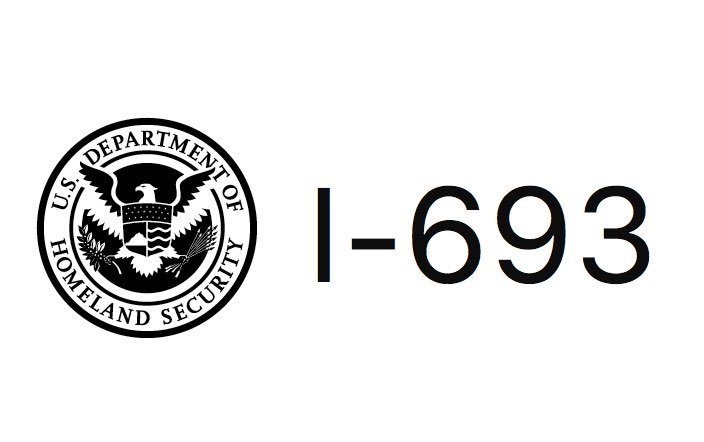Instructions for completing Form I-693 in Spanish

Form I-693, known as the Report of Medical Examination and Immunization Record, is a document required by U.S. Citizenship and Immigration Services (USCIS) to verify that applicants for certain types of adjustment of status do not have health-based inadmissibilities.
This form is crucial because an unfavorable outcome could result in denial of adjustment of status, for example, when applying for permanent residence (green card).
Step 1: Preparation Before Filing Form I-693
1.1 Understanding the Importance of the Form
Before initiating any paperwork, it is essential to understand why Form I-693 is required. USCIS uses this form to ensure that you do not bring communicable diseases into the United States, do not possess disorders that may be dangerous to the public, and meet the country’s vaccination requirements.
For example, if Juan, a Honduran residing in Texas, wishes to adjust his status, he must demonstrate that he is free of significant diseases such as tuberculosis and that he has received all required vaccinations, such as varicella and MMR (measles, mumps and rubella).
1.2 Reading the Official Instructions
It is crucial to read all instructions provided by USCIS before proceeding. These instructions are available on the USCIS website and provide specific details on how to properly complete and file the form.
In addition, they include a FAQ section that can solve many of the doubts you may have. You can access these instructions directly from USCIS – Form I-693.
1.3 Finding a Designated Civil Surgeon
For the medical examination, you must visit a civil surgeon designated by USCIS. Not just any doctor can perform this test. USCIS provides a search tool on its website to find licensed physicians near your location.
Suppose Maria, another Honduran living in Miami, needs to find a civil surgeon; she would log on to the USCIS website and use the “Find a Doctor” tool to locate a nearby doctor who can perform her exam.
Link to find a physician: Find a Licensed Physician
1.4 Preparing the Necessary Documentation
Prior to your appointment with the civil surgeon, be sure to gather all necessary medical documentation, including previous vaccination records and any relevant medical history. This is important because the physician will need this information to complete the form properly.
For example, if Carlos, a New York resident, has a medical history of treated tuberculosis, he should bring with him not only proof of treatment but also test results confirming that he is cured.
Proper preparation prior to filing Form I-693 is crucial to ensure that the process goes smoothly.
Make sure you understand the purpose of the form, read all USCIS instructions, find a licensed civil surgeon, and gather all necessary medical documentation. This initial step is critical to avoid delays or problems with your adjustment of status application.
Step 2: During the Medical Appointment
2.1 Appointment Day
On the day of your appointment, be sure to arrive on time and bring all necessary documentation with you, including a valid government-issued ID (e.g., passport or driver’s license) and your medical and vaccination records.
It is crucial to present a valid form of identification so that the physician can verify your identity before performing the exam. For example, Ana, a Honduran woman residing in Los Angeles, must bring her valid passport to prove her identity to the civil surgeon.
2.2 Medical Examination Procedure
During the appointment, the civil surgeon will perform a complete physical examination, review your medical history and confirm that all of your immunizations are up to date according to the requirements of the U.S. Centers for Disease Control and Prevention (CDC).
This may include additional tests such as blood tests, tuberculosis tests and x-rays. If any vaccines are missing, the civil surgeon can administer them during the appointment.
For example, if Chicago resident Jose is missing his hepatitis B vaccination, the civil surgeon can administer it during his appointment to ensure that he meets all health requirements for his adjustment of status.
2.3 Completing Form I-693
After the examination, the civil surgeon will complete Form I-693 based on the results of the examination. It is crucial that you do not sign the form until the physician instructs you to do so and always in his/her presence.
This is part of the verification process to ensure that all information is correct and complete.
Step 3: After the Examination
3.1 Receiving Sealed Form I-693
Once the medical examination is complete and the form properly filled out, the civil surgeon will place the Form I-693 in a sealed envelope. It is important that you do not open this envelope as USCIS will reject it if it is opened or altered.
The physician should also give you a copy of the completed form for your records.
For example, if Laura, a Houston resident, receives her form in a sealed envelope, she should be sure not to open it and keep it in a safe place until she needs to file it with USCIS.
3.2 Submitting Form I-693 to USCIS
Generally, you will submit the sealed envelope as part of your application for adjustment of status. You may be asked to submit the form during your interview with USCIS or mail it according to the specific instructions for your case.
Final Recommendations
It is advisable to keep a copy of all documentation sent to USCIS, including a copy of Form I-693 for your personal records. Also, be sure to follow any specific instructions that USCIS has given you regarding when and how to file your Form I-693.
Useful Links and Resources
This manual is intended to help you understand and correctly complete Form I-693, ensuring that your adjustment of status application process runs as smoothly as possible.






